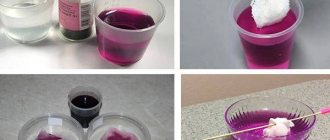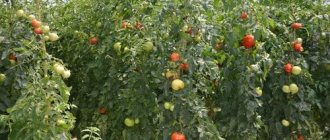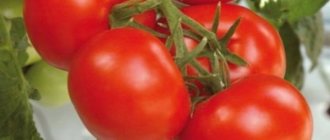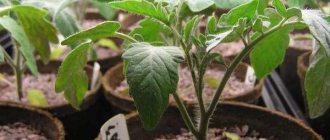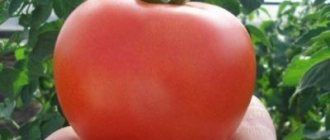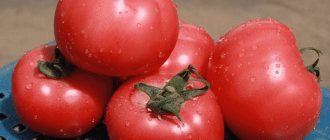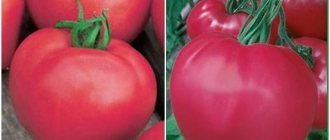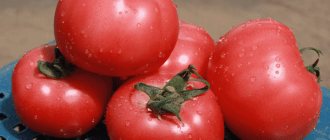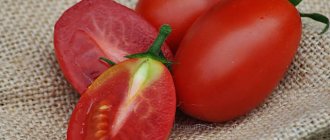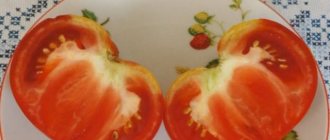Description of the hybrid
The main features of Strega tomatoes are that the bushes are tall and form many shoots. The plant is not susceptible to fungal diseases, but for prevention purposes it is necessary to remove the lower leaves up to 1/3 of the height of the bush.
Distinctive features
Tomato Strega is characterized by the following characteristics:
- early ripening large-fruited hybrid, indeterminate;
- 3 months pass from the first shoots to the appearance of fruits;
- the plant is strong, the internodes are short;
- the first inflorescences are laid above the ninth leaf blade;
- up to 6 fruits are formed in one cluster, while on the upper clusters the size of the tomatoes is maintained;
- Suitable for growing in all types of greenhouses, as well as in open ground.
Fruit characteristics, yield indicators
The fruits of the Strega f1 hybrid have the following features:
- the shape of the tomatoes is round, they are flat on top and bottom;
- medium ribbed;
- The color of the fruit is deep red;
- the weight of one tomato reaches 200–250 g;
- The fruits are dense, while their flesh is fleshy and juicy.
Reference! The yield of Strega tomato per 1 square meter is 20-25 kg.
How to grow seedlings
Sowing of seeds is carried out no earlier than 60 days before planting in open ground. Only in this case can you grow beautiful, healthy, but not overgrown seedlings.
Seed preparation
Hybrid seeds do not require culling. However, it will not be superfluous to disinfect the seed material.
There are several options for this procedure:
- Place the seeds placed in a gauze bag into a weak solution of potassium permanganate;
- soak the seeds in the Fitosporin solution;
- soak the seeds in a soda solution (a teaspoon of soda per glass of water) - this procedure will not only destroy pathogens, but will also speed up the emergence of seedlings.
After disinfection, it is recommended to immerse the seeds in a growth stimulator for a day.
Attention! To prepare solutions, use settled, rain or melt water.
Container and soil
Ready-made store-bought soil for indoor plants is suitable for growing seedlings. You can also prepare the soil mixture yourself.
To do this you will need the following components:
- peat;
- compost or humus;
- turf or leaf soil;
- sand (it is best to take river sand - it is coarser).
Reference! Sand is taken in half as much as other components.
To 10 liters of soil mixture add a glass of wood ash (can be replaced with crushed chalk), as well as a tablespoon of mineral fertilizers. All ingredients are thoroughly mixed.
The substrate also needs to be disinfected. To do this, place it in the oven preheated to 100°C for 60 minutes.
As a container for planting, it is best to choose peat pots, tablets or special boxes and cassettes for seedlings.
Sowing
Small holes are made at the bottom of the planting container. After this, soil is poured there. Seeds are planted in the soil to a depth of 1 cm, with a distance between seeds of 3 cm. 3–6 seeds can be placed in peat pots, and 2–4 in tablets.
It is better to spill the soil with water in advance so as not to wash out the seeds with a stream of water. The containers are covered with film or glass and placed in a warm room. The optimal temperature for seeds is 28–30°C.
Attention! You cannot place containers on batteries.
Every day the film is opened for a few minutes. When the first sprouts appear, it is removed.
How to grow tomatoes
To grow a rich and tasty harvest of Strega f1 tomatoes, follow our recommendations.
Landing
It is best to plant seedlings in open ground in cloudy weather or in the evening. The distance between the rows is 50–70 cm, and the sprouts are spaced 30–40 cm apart from each other.
Landing algorithm:
- Make holes 15 cm deep.
- Sprinkle each hole with plenty of water.
- Plant the seedlings, deepening them to the cotyledon leaves.
- Sprinkle the seedlings with soil, compact it so that the sprouts do not fall.
Important! Overgrown seedlings are tied to stakes.
Seedling care
Basic procedures for obtaining a rich harvest:
- Watering. There is no need to water the first week after planting the seedlings, because the sprouts need to take root. Then watering is carried out as the soil dries. The optimal water consumption for 1 bush is 2–5 liters. Tomatoes are watered only at the root, and not from above. It is recommended to loosen it every time the soil is moistened.
- Feeding. Fertilizers are applied for the first time 15–20 days after planting the seedlings. To do this, use ready-made complex formulations and prepare the solution in accordance with the instructions. The tomatoes are fed the second time after the first flowering and during the formation of buds. Fertilize the third time during the appearance of the first fruits.
- Pinching and pruning . Stepchildren take nutrients from plants, so they need to be removed. If this is not done, the growth of tomatoes and their fruiting will slow down, and may even stop altogether. Experts advise getting rid of unnecessary shoots exclusively with your fingers, without using pruners and scissors, while leaving stumps 1 cm long. Also, the Strega hybrid gets rid of the lower leaves - this procedure is performed after the first ovaries appear. Trimming the lower leaves is done with pruners or scissors.
- Garter. As soon as the bush grows above 50 cm, it is recommended to tie it up. It is best to use trellises.
Features of cultivation and possible difficulties
In equipped greenhouses, Strega f1 tomato is grown even in winter. The culture is unpretentious to climatic conditions.
In open ground, it is not recommended to plant seedlings in a sunny place, otherwise the leaf blades will be burned. It is better to choose partial shade. Tomatoes should be protected from drafts. You cannot plant seedlings in a wetland. This will cause the stems and leaves to rot.
Diseases and pests
You should be concerned if spots appear on the leaf blades and fruits. The appearance of mold on the leaves is also dangerous. If such diseases occur, the affected parts must be removed and then the plant must be treated with fungicides.
Large-fruited and early-ripening hybrid for universal use - tomato “Strega f1”
The hybrid tomato Strega f1 is in demand among gardeners due to its high yields and unpretentiousness in agricultural technology.
We will tell you in detail about growing tomato seedlings and further caring for the plant, as well as possible problems and ways to solve them.
Description of the hybrid
The main features of Strega tomatoes are that the bushes are tall and form many shoots. The plant is not susceptible to fungal diseases, but for prevention purposes it is necessary to remove the lower leaves up to 1/3 of the height of the bush.
Distinctive features
Tomato Strega is characterized by the following characteristics:
- early ripening large-fruited hybrid, indeterminate;
- 3 months pass from the first shoots to the appearance of fruits;
- the plant is strong, the internodes are short;
- the first inflorescences are laid above the ninth leaf blade;
- up to 6 fruits are formed in one cluster, while on the upper clusters the size of the tomatoes is maintained;
- Suitable for growing in all types of greenhouses, as well as in open ground.
Fruit characteristics, yield indicators
The fruits of the Strega f1 hybrid have the following features:
- the shape of the tomatoes is round, they are flat on top and bottom;
- medium ribbed;
- The color of the fruit is deep red;
- the weight of one tomato reaches 200–250 g;
- The fruits are dense, while their flesh is fleshy and juicy.
Reference! The yield of Strega tomato per 1 square meter is 20-25 kg.
How to grow seedlings
Sowing of seeds is carried out no earlier than 60 days before planting in open ground. Only in this case can you grow beautiful, healthy, but not overgrown seedlings.
Seed preparation
Hybrid seeds do not require culling. However, it will not be superfluous to disinfect the seed material.
There are several options for this procedure:
- Place the seeds placed in a gauze bag into a weak solution of potassium permanganate;
- soak the seeds in the Fitosporin solution;
- soak the seeds in a soda solution (a teaspoon of soda per glass of water) - this procedure will not only destroy pathogens, but will also speed up the emergence of seedlings.
After disinfection, it is recommended to immerse the seeds in a growth stimulator for a day.
Attention! To prepare solutions, use settled, rain or melt water.
Container and soil
Ready-made store-bought soil for indoor plants is suitable for growing seedlings. You can also prepare the soil mixture yourself.
To do this you will need the following components:
- peat;
- compost or humus;
- turf or leaf soil;
- sand (it is best to take river sand - it is coarser).
Reference! Sand is taken in half as much as other components.
To 10 liters of soil mixture add a glass of wood ash (can be replaced with crushed chalk), as well as a tablespoon of mineral fertilizers. All ingredients are thoroughly mixed.
The substrate also needs to be disinfected. To do this, place it in the oven preheated to 100°C for 60 minutes.
As a container for planting, it is best to choose peat pots, tablets or special boxes and cassettes for seedlings.
Sowing
Small holes are made at the bottom of the planting container. After this, soil is poured there. Seeds are planted in the soil to a depth of 1 cm, with a distance between seeds of 3 cm. 3–6 seeds can be placed in peat pots, and 2–4 in tablets.
It is better to spill the soil with water in advance so as not to wash out the seeds with a stream of water. The containers are covered with film or glass and placed in a warm room. The optimal temperature for seeds is 28–30°C.
Attention! You cannot place containers on batteries.
Every day the film is opened for a few minutes. When the first sprouts appear, it is removed.
Growing and caring for seedlings
With the appearance of the first shoots, the seedlings are transferred to a cool place with a temperature of 16–18°C. After 7–10 days, the sprouts are transferred again to a warm place with a temperature of 20–22°C; at night it should be cooler – 14–16°C.
Important! Protect seedlings from drafts.
Rules for caring for seedlings:
- Watering. The roots of tomato seedlings are delicate, so water the sprouts carefully, along the edges of the container; use a watering can without a nozzle. It is also necessary to spray the plant once a day, twice on dry days.
- Lighting . Young sprouts require a lot of light, so it is recommended to place the seedlings on a southern windowsill or loggia. If there is a lack of natural light, a phytolamp is used. The containers are rotated periodically so that the plants do not pull in one direction.
- Dive. If the seedlings are located too densely, they need to be planted immediately after the first leaves appear. The sprouts are transplanted to a depth of 3-4 cm with a distance between them of 5–7 cm. The seedlings are planted together with a lump of earth. After 20–22 days, repeat diving is carried out in a larger container.
- Feeding. 15–20 days after the first shoots, the seedlings are fed. Feeding is carried out regularly, every 10 days. You can choose ready-made complex fertilizers, or you can take wood ash, eggshells or chicken droppings.
Reference! Fertilizers are applied after moistening the soil in the morning or evening.
How to grow tomatoes
To grow a rich and tasty harvest of Strega f1 tomatoes, follow our recommendations.
Landing
It is best to plant seedlings in open ground in cloudy weather or in the evening. The distance between the rows is 50–70 cm, and the sprouts are spaced 30–40 cm apart from each other.
Landing algorithm:
- Make holes 15 cm deep.
- Sprinkle each hole with plenty of water.
- Plant the seedlings, deepening them to the cotyledon leaves.
- Sprinkle the seedlings with soil, compact it so that the sprouts do not fall.
Important! Overgrown seedlings are tied to stakes.
Seedling care
Basic procedures for obtaining a rich harvest:
- Watering. There is no need to water the first week after planting the seedlings, because the sprouts need to take root. Then watering is carried out as the soil dries. The optimal water consumption for 1 bush is 2–5 liters. Tomatoes are watered only at the root, and not from above. It is recommended to loosen it every time the soil is moistened.
- Feeding. Fertilizers are applied for the first time 15–20 days after planting the seedlings. To do this, use ready-made complex formulations and prepare the solution in accordance with the instructions. The tomatoes are fed the second time after the first flowering and during the formation of buds. Fertilize the third time during the appearance of the first fruits.
- Pinching and pruning . Stepchildren take nutrients from plants, so they need to be removed. If this is not done, the growth of tomatoes and their fruiting will slow down, and may even stop altogether. Experts advise getting rid of unnecessary shoots exclusively with your fingers, without using pruners and scissors, while leaving stumps 1 cm long. Also, the Strega hybrid gets rid of the lower leaves - this procedure is performed after the first ovaries appear. Trimming the lower leaves is done with pruners or scissors.
- Garter. As soon as the bush grows above 50 cm, it is recommended to tie it up. It is best to use trellises.
Features of cultivation and possible difficulties
In equipped greenhouses, Strega f1 tomato is grown even in winter. The culture is unpretentious to climatic conditions.
In open ground, it is not recommended to plant seedlings in a sunny place, otherwise the leaf blades will be burned. It is better to choose partial shade. Tomatoes should be protected from drafts. You cannot plant seedlings in a wetland. This will cause the stems and leaves to rot.
Diseases and pests
You should be concerned if spots appear on the leaf blades and fruits. The appearance of mold on the leaves is also dangerous. If such diseases occur, the affected parts must be removed and then the plant must be treated with fungicides.
The hybrid is resistant to the following diseases:
The best remedies for tomato diseases are prevention (disinfection of seeds and soil, loosening, weeding) and proper agricultural technology.
The nuances of growing in open ground and greenhouses
When growing Strega tomatoes, you should consider the following points:
- seeds are sown in mid-March;
- a week before planting seedlings, they need to be hardened off;
- in May it is better to plant seedlings under film, in June - in open ground;
- the plant needs constant watering, fertilizing and loosening.
In a greenhouse, plantings require regular ventilation. To improve pollination, it is recommended to shake the bushes periodically.
Harvesting and application
They begin to harvest in early August and continue to harvest ripe tomatoes until mid-September.
Most often, Strega tomatoes are used fresh; they are well suited for appetizers, salads and sandwiches. Tomatoes can also be used to make hot sauces and soups.
Advantages and disadvantages of the type
The main advantages of the Strega f1 hybrid:
- good formation of ovaries at different temperatures;
- excellent taste;
- presentation and transportability;
- resistance to many diseases.
Agronomists have not identified any serious deficiencies in the Strega tomato.
Farmer reviews
Sergey, Belgorod: “I plant the Strega f1 hybrid every year for sale. These are the tomatoes that are taken away from me first. I use mulch to retain moisture in the soil.”
Natalya, Vladimir: “I planted Strega for the first time on the recommendation of a friend. I watered the tomatoes generously, three times a week. The harvest result exceeded all my expectations. The tomatoes came out smooth and beautiful, just like in the photo of the packet of seeds.”
Evgeniya, Zlatoust: “Strega gives an excellent harvest even in a bad year. The bushes grow powerful and delight with an abundance of ovaries. I plant tomatoes at a distance of 1 m from each other.”
The nuances of growing in open ground and greenhouses
When growing Strega tomatoes, you should consider the following points:
- seeds are sown in mid-March;
- a week before planting seedlings, they need to be hardened off;
- in May it is better to plant seedlings under film, in June - in open ground;
- the plant needs constant watering, fertilizing and loosening.
In a greenhouse, plantings require regular ventilation. To improve pollination, it is recommended to shake the bushes periodically.
Indeterminate varieties
Tall plants require additional care. For strength and durability, it is recommended to tie the crop vertically.
Tall Kibo F1
The plant is tall. The bush grows tall and is constantly developing. It bears fruit for a long time (almost until the first frost), and is considered an early ripening plant. Resistance to stress allows a small sprout to quickly grow into a tall plant that constantly produces clusters of flowers. The ovary is almost one hundred percent, up to 5-6 tomatoes are formed on each hand.
Gardeners growing Kibo F1 tomato on their plots note that ripe vegetables have excellent taste and do not lose this property until the last tomato. The average weight of the fruit is about 300 g. Dense texture, sugary taste, long shelf life are the main positive characteristics from lovers of Kibo tomatoes.
High yield from Kirzhach F1
Optimistic reviews about the Kirzhach F1 tomato can be read even from novice vegetable growers. Breeders classify the crop as mid-season, promising a harvest 110-115 days after germination. The plant grows tall and powerful (indeterminate), independently forming two stems. The fruits ripen relatively smoothly. Ripe tomatoes are red in color and weigh about 150 g. The dense consistency and soft peel allow us to recommend Kirzhach for fresh consumption.
Disease resistant Kohawa F1
An early ripening hybrid that produces the first harvest 85-90 days after germination. An adult plant has dense foliage and is of the vegetative type. The fruits set stably at both high and low temperatures, which makes the Kokhava F1 tomato desirable in the greenhouses of most residents of the Moscow region. Beautiful flat-round fruits ripen on one cluster in the amount of 5-6 pieces. The color of a ripe tomato is beautiful scarlet. The fruits are well transported and have excellent commercial qualities.
Farmer reviews
Sergey, Belgorod: “I plant the Strega f1 hybrid every year for sale. These are the tomatoes that are taken away from me first. I use mulch to retain moisture in the soil.”
Natalya, Vladimir: “I planted Strega for the first time on the recommendation of a friend. I watered the tomatoes generously, three times a week. The harvest result exceeded all my expectations. The tomatoes came out smooth and beautiful, just like in the photo of the packet of seeds.”
Evgeniya, Zlatoust: “Strega gives an excellent harvest even in a bad year. The bushes grow powerful and delight with an abundance of ovaries. I plant tomatoes at a distance of 1 m from each other.”
General characteristics of the variety
The bushes are indeterminate, tall, and in greenhouse conditions can reach 1.5 m or more. To obtain high yields per unit area, compacted planting (4-5 plants per 1 m²) and the formation of tomatoes into 1-2 stems is recommended. Under such conditions, the yield of the variety is up to 24 kg per 1 m².
When grown in open ground, the tomato harvest may be slightly smaller (up to 20 kg). The decrease in the number of fruits occurs due to the fact that the last clusters do not have time to form full-fledged ovaries. But even taking into account the losses, Strega tomatoes can be considered one of the highest-yielding hybrids.
The description of the variety by those who planted Strega notes that the plant has strong growth and forms many stepsons. To form a bush, leave 1-2 pieces, but the rest must be removed as they appear. An overly dense bush can reduce yield. In order for tomatoes to reduce the formation of green mass, it is recommended to apply nitrogen fertilizers (organic matter) in the fall, and in the summer to limit ourselves to only adding a complex of minerals for flowering and fruiting (phosphorus and potassium).
Strega tomatoes are not susceptible to fungal diseases. But to prevent late blight, part of the lower leaves (up to 1/3 of the height of the bush) should be removed. In well-ventilated plots, tomatoes are practically not affected by this dangerous disease, and even late-harvested unripe fruits ripen well in boxes.
Features of cultivation
The modern early Strega tomato makes it possible to obtain fresh vegetable products already at the beginning of summer, when the shortage is felt most strongly. The hybrid is distinguished by its friendly yield, which makes it convenient for growing on small farms and in summer cottages. Resistance to adverse weather conditions allows us to recommend these tomatoes for different regions of Russia.
The bushes are indeterminate, tall, and in greenhouse conditions can reach 1.5 m or more. To obtain high yields per unit area, compacted planting (4-5 plants per 1 m²) and the formation of tomatoes into 1-2 stems is recommended. Under such conditions, the yield of the variety is up to 24 kg per 1 m².
When grown in open ground, the tomato harvest may be slightly smaller (up to 20 kg). The decrease in the number of fruits occurs due to the fact that the last clusters do not have time to form full-fledged ovaries. But even taking into account the losses, Strega tomatoes can be considered one of the highest-yielding hybrids.
The description of the variety by those who planted Strega notes that the plant has strong growth and forms many stepsons. To form a bush, leave 1-2 pieces, but the rest must be removed as they appear. An overly dense bush can reduce yield. In order for tomatoes to reduce the formation of green mass, it is recommended to apply nitrogen fertilizers (organic matter) in the fall, and in the summer to limit ourselves to only adding a complex of minerals for flowering and fruiting (phosphorus and potassium).
Strega tomatoes are not susceptible to fungal diseases. But to prevent late blight, part of the lower leaves (up to 1/3 of the height of the bush) should be removed. In well-ventilated plots, tomatoes are practically not affected by this dangerous disease, and even late-harvested unripe fruits ripen well in boxes.
Hybrid Strega is a beef tomato. This means that the plant produces large, flat-rounded fruits with an average weight of about 300 g. The pulp of such tomatoes contains few seeds. 5-6 fruit tassels grow on the bush. On average, 5 pieces are tied on each of them. fruits that grow evenly and ripen almost simultaneously. Fruiting is extended; the last fruits in open ground can be collected in early September.
The skin of the fruit is thin but durable. The ovaries do not crack even under unfavorable growing conditions. Reviews from those who grew such tomatoes note the high keeping quality and excellent transportability of ripe fruits. The color of the shell at biological ripeness is bright red.
READ MORE: White filling apples description and characteristics of the variety useful properties
The pulp has a dense structure, very juicy and meaty. On the cut, the seed chambers are almost invisible. The color is rich, uniform, without light areas. Characteristics of taste merits indicate an increased content of dry substances and sugars: the tomato is sweet with a slight piquant sourness. Those who grew tomatoes in rainy and cold summers note a decrease in taste.
The purpose of the variety is fresh use. The harvest can be harvested 80-90 days after germination, so fresh greenhouse tomatoes can be consumed already in mid-June. They are well suited for sandwiches and gourmet snacks, look impressive in salads and slices, and are suitable for hot sauces and soups.
Sowing of seed material is carried out no earlier than 2 months before planting. In this case, it will be possible to obtain strong and strong seedlings that are not overgrown. Seeds are sown in common boxes and germinated at a temperature of 25°C. After 2-3 leaves appear, the seedlings dive at a distance of 10 cm from each other. When growing seedlings, the soil should not be allowed to dry out, as this weakens the plants.
Planting takes place in mid-late May. Depending on the method of cultivation, it can be planted in a greenhouse already in the 2nd decade of May, and in open ground when the return frosts have passed.
Watch the video! Tomato variety Strega F1
The hybrid was developed specifically for greenhouses; it is suitable for farmers planting tomatoes for sale in greenhouse complexes. In the south it is possible to plant in open ground.
The bushes grow into stepsons, preferably in 1 stem. Tied to a support. A month before the end of the harvest season, you need to pinch the growing point so that the green mass no longer develops, and the bush spends energy on ripening the fruits.
Tomatoes store well and can be transported over long distances.
Description of the variety
REFERENCE: When processed, tomatoes produce tasty and healthy tomato juice.
The popularity of hybrid tomatoes is growing from year to year. While some gardeners prefer varietal crops, others successfully cultivate hybrids on their plots. Tomato Stresa f1 is just one of these. It is valued for its ease of care, high productivity and excellent taste.
In this article, we have prepared an overview of the main characteristics of the crop, the pros and cons, and the nuances of agricultural technology in greenhouses.
Description of the hybrid
Tomato Stresa f1 is a mid-early hybrid for cultivation in closed ground. Seed biologists were involved in breeding the crop. The hybrid is recommended for winter-spring and spring-summer rotation.
Indeterminate bushes with an unlimited growth point grow up to 2 m and require the removal of stepsons and tying to supports. The plant is compact in size, with medium internodes. The first inflorescence is formed above the 8-9th leaf, the rest - after two leaves. 5–7 ovaries are formed on one brush.
The photo shows a hybrid tomato Stresa f1.
The table summarizes the distinctive features of tomatoes.
| Indicators | Characteristic |
| Weight | 180-230 g |
| Form | Flat-round, medium ribbed |
| Coloring | Unripe fruits are green with a dark spot near the stalk, ripe ones are red. |
| Leaves | Medium size, green |
| Inflorescence | Simple |
| Pulp | Dense, with few seeds |
| Taste | Sweet and sour |
| Skin | Dense, smooth and shiny, does not crack. |
| Number of slots | Four or more |
| peduncle | With articulation |
| Purpose | Universal |
| Ripening period | 95–115 days after germination |
| Productivity | 25 kg/m² |
| Sustainability | Tomato mosaic virus, cladosporiosis, fusarium, verticillium, root-knot nematodes |
| Transportability | High |
The crop is grown through seedlings. Sowing work begins in the second ten days of March, 60–65 days before transferring to closed ground.
Seeds do not need to be treated with potassium permanganate or soaked in growth stimulants before sowing. This is what they do in production.
To identify empty grains, a calibration method is used. The seeds are soaked for 10 minutes in a saline solution (1 tsp per glass of water at room temperature). Poor quality material will float to the surface; it is not used for sowing. The seeds remaining at the bottom of the glass are washed with warm running water.
Soil for growing seedlings is prepared from equal parts of turf, peat and river sand with the addition of superphosphate (40 g per bucket of soil mixture). They also use ready-made substrate in bags for growing seedlings of peppers and tomatoes. Such soil is already enriched with nutrients.
Before use, the soil is disinfected in an oven, steamer, and treated with a solution of potassium permanganate or “Fitosporin M”. The procedure prevents the development of bacteria and fungi in the soil.
For sowing seeds, cassettes, boxes, plastic trays, pots, juice or milk tetrapacks are used. The seeds are placed in moist soil to a depth of 2 cm with an interval of 2–3 cm. A film is pulled over the top to create greenhouse conditions and the containers are taken to a dark, warm place. The seeds hatch after 4-5 days at a temperature of 25 °C.
After the shoots appear, the film is removed and the containers are taken to a lighted place. The duration of daylight should be at least 15–16 hours. To prevent seedlings from stretching out and gaining strength faster when there is a lack of sunlight, fluorescent lamps are installed above them.
Seedlings do not like overwatering, so instead of a watering can, use a spray bottle.
At the stage of 2-3 leaves, seedlings are planted in individual pots made of plastic or peat. A week after picking, the seedlings are fed once with Effecton or Agricola.
At home it is easy to prepare universal foliar and root feeding:
- 20 g superphosphate;
- 10 g of potassium sulfate;
- 5 g urea.
Hybrid Stresa f1 is grown in protected ground using standard methods. The soil and greenhouses are prepared in the fall. In the spring, they are re-loosened and fertilized with humus. Indeterminate plants need pinching, staking, moderate watering and the application of organic and mineral fertilizers.
Landing
The strengthened seedlings are transferred to a permanent place in mid-May. The soil is dug up in the fall, plant debris is removed along with the roots and a bucket of humus is added per 1 m². At the beginning of spring, the soil is loosened and fertilized with humus - 10 liters per square meter.
Holes 20 cm deep are dug in a checkerboard pattern every 40 cm. The distance between the rows is 70 cm. Cool boiling water is poured into each hole, a handful of wood ash and a tablespoon of superphosphate are added. Seedlings are moistened abundantly with warm water and planted in holes.
After planting, the soil is covered with black agrofibre to prevent the growth of weeds, the spread of fungi and bacteria, and reduce labor costs for caring for tomatoes. Instead of synthetic fiber, straw, peat, sawdust, and pine needles are used.
READ MORE: Madeira tomato - description and characteristics of the variety
The bushes are formed into two stems by removing young shoots after the fifth cluster and tied to high wooden supports or a trellis. The procedure stimulates the formation of ovaries and increases productivity.
Tomatoes prefer moderate watering with warm rain or settled water at the root in the morning or evening. Installing a drip irrigation system will help optimize plant care.
Young bushes require about 5 liters of water, adults – 10 liters. Watering frequency is once every 10–12 days.
The Stresa hybrid needs regular feeding with organic and mineral compounds. During the growing season, plants are fertilized 3-4 times. The first fertilizing with organic matter is carried out two weeks after planting. An infusion of chicken manure (20 g per 10 liters of water) or mullein (1 liter of infusion per 10 liters of water) is suitable for this. Ready-made organic fertilizers are popular: “Pixa”, “Vermix”, “Ripen-ka”, “Reliable”.
Description of Strega tomato fruits
Hybrid Strega is a beef tomato. This means that the plant produces large, flat-rounded fruits with an average weight of about 300 g. The pulp of such tomatoes contains few seeds. 5-6 fruit tassels grow on the bush. On average, 5 pieces are tied on each of them. fruits that grow evenly and ripen almost simultaneously. Fruiting is extended; the last fruits in open ground can be collected in early September.
The skin of the fruit is thin but durable. The ovaries do not crack even under unfavorable growing conditions. Reviews from those who grew such tomatoes note the high keeping quality and excellent transportability of ripe fruits. The color of the shell at biological ripeness is bright red.
The pulp has a dense structure, very juicy and meaty. On the cut, the seed chambers are almost invisible. The color is rich, uniform, without light areas. Characteristics of taste merits indicate an increased content of dry substances and sugars: the tomato is sweet with a slight piquant sourness. Those who grew tomatoes in rainy and cold summers note a decrease in taste.
The purpose of the variety is fresh use. The harvest can be harvested 80-90 days after germination, so fresh greenhouse tomatoes can be consumed already in mid-June. They are well suited for sandwiches and gourmet snacks, look impressive in salads and slices, and are suitable for hot sauces and soups.
Tomatoes can be processed into juice and sauces. The intense color of the pulp makes it possible to obtain classic tomato juice; lecho or ketchup is made from the boiled pulp. Only fruits cut into slices can be preserved.
Description of the Strega tomato variety, its characteristics and productivity
Tomato Strega f1 is classified as an early indeterminate variety of tomato. The positive qualities of this vegetable crop are the reason for its fairly high popularity among vegetable growers in various regions of our country. What is so interesting about this early-ripening hybrid variety, and how does it stand out among other similar types of tomatoes?
Description and main characteristics of the variety
Strega f1 tomatoes are early, so the period from sprouting to harvesting ripe fruits is about 3 months. Those who have planted this hybrid for more than one season have left their reviews on the tomato forum. According to them, fruits are set on the bushes in any weather conditions - in the hot season or in a rainy, cloudy summer.
This variety was bred for cultivation in a short summer season and is intended for cultivation in closed ground, but in warm regions it can also be planted in open ground. The seeds of this hybrid are sold by the well-known seed-growing company Semco Junior.
The description of the variety should begin with a story about the bushes of these tomatoes. The bushes are tall, powerful with short internodes. The shoots are powerful, strong, usually reach 1.4-1.5 m in height, and have medium foliage. The foliage is larger than average, typically tomato, and the color is bright emerald. Since the stems are very tall and the mass of ripening fruits is quite large, the bushes require garters (so that the shoots do not break under the weight of the harvest). In order for tomatoes to grow large enough and ripen on the bush, the bush should be formed with no more than three shoots.
The first ovaries are usually formed above 8-9 leaves. The inflorescences are simple, collected in clusters of 5-6 pieces each. Each stem produces 5-6 clusters. The stalks are articulated. Ripe tomatoes are round, slightly flattened, rich scarlet in color. The weight of one tomato can be up to 270-300 g. The commercial quality of the tomatoes is excellent, there are no spots or stripes of a different color on the skin, the color of ripe tomatoes is uniform. Harvest ripening is amicable.
The productivity of Strega tomatoes is high, usually up to 23-25 kg per 1 m2 in a greenhouse; in open ground these figures decrease slightly - to 20-22 kg. But to get a high harvest, summer residents will have to work hard.
The thickness of the skin is medium, not prone to cracking. The pulp is fleshy, juicy, with good taste. According to its characteristics, the Strega tomato ranks one of the first places among salad hybrids.
The transportability of the crop is high; during transportation, tomatoes do not lose either their presentation or taste. When picked at the stage of technical maturity, tomatoes can ripen indoors.
Resistance to the main diseases to which nightshade vegetable crops are susceptible is inherent in this hybrid at the genetic level. Particular resistance to the following diseases has been noted:
- fusarium;
- withering;
- verticillium;
- late blight;
- tobacco mosaic virus.
Those who planted this hybrid for the first time this season have already managed to appreciate all the advantages of these tomatoes. Moreover, some correspondents from different regions of Russia write about the Strega tomato in approximately the same way: “I am growing these tomatoes for the first time. I planted it on the recommendation of my neighbors in the dacha cooperative and I don’t regret it at all. A large harvest of tasty large tomatoes has been harvested. I will continue to plant.”
How to grow large tomatoes?
Sowing of seed material is carried out no earlier than 2 months before planting. In this case, it will be possible to obtain strong and strong seedlings that are not overgrown. Seeds are sown in common boxes and germinated at a temperature of +25°C. After 2-3 leaves appear, the seedlings dive at a distance of 10 cm from each other. When growing seedlings, the soil should not be allowed to dry out, as this weakens the plants.
Planting takes place in mid-late May. Depending on the method of cultivation, it can be planted in a greenhouse already in the 2nd decade of May, and in open ground when the return frosts have passed.
Description of tomato Stresa F1, reviews, photos
Medium-early, tall, productive tomato hybrid. In the middle zone, it is recommended to grow it in a greenhouse. The period from germination to the beginning of ripening is 94-115 days.
Bush of indeterminate type, up to 1.7 meters high. The plant is compact, internodes are medium. The first inflorescence is laid above the 8–9th leaf, subsequent ones - every 2–3 leaves . 5–7 fruits are formed in the brush. The plant requires staking to a support and pinching. The manufacturer recommends growing it in 1 stem, removing all stepsons.
Fruit characteristics
The fruits are flat-round, slightly ribbed at the stalk, shiny, red in color at maturity, weighing 180–200 grams, good (for a hybrid) taste. Not prone to cracking, transportable. These tomatoes are suitable for early fresh salads and processing.
The hybrid is resistant to tomato mosaic virus, cladosporiosis, fusarium, verticillium and root-knot nematodes.
Planting pattern : 70 x 40 cm.
If you grew Stresa F1 tomatoes, please write whether you liked them or not. What was the yield and taste of the fruits like under your climatic conditions? How do you rate the disease resistance of this hybrid? If possible, attach a photo of your tomatoes to your comment. Thank you!
Your reviews of the Stresa tomato and additions to the description will help many gardeners evaluate this hybrid more objectively and decide whether it is worth planting or not.
Description of the tomato variety Tmag 666 f1, characteristics and methods of cultivation
Another new variety has already earned positive reviews from agronomists; it was bred by breeders from the Chinese company Sakata. The hybrid is suitable for growing over large areas and has excellent taste. Let's consider the description of the variety and growing conditions in the middle climate zone.
Hybrid characteristics
Tomato hybrid f1 Tmag 666 f1 is an early-ripening determinate type of cultivation, suitable for cultivation in open areas, in greenhouses and at home. The bush is compact in size, low, powerful stems with a lot of leaves. Does not require stepsoning.
The fruits are dense, round - the average weight of one tomato is 260-300 grams. The color is red, bright. The stalk lacks a green spot. Ripening fruits are perfectly protected by leaves from ultraviolet rays.
The variety is resistant to diseases such as Fusarium wilt, Yellow leaf curl, Alternaria canker, Verticillium wilt.
The fruits are intended for fresh consumption.
Positive traits
Due to their characteristics they have the following positive qualities.
- Early ripening.
- Good disease resistance.
- Long shelf life.
- Transportability.
- Good presentation.
- High taste qualities.
- Easy to grow.
Agricultural technology
Since Tmag seeds have undergone pre-sale treatment with Thiram, there is no need to soak them in fungicides in the future.
Seeds are sown in March for seedlings in compacted soil, sprinkled with peat or a 1-centimeter layer of soil, watered with warm water from a spray bottle, and covered with film. The container is placed in a sunny place for germination.
After germination, the film is removed and the plants continue to be grown at an air temperature of 20 degrees until 1-2 true leaves appear. Then the seedlings are planted in separate containers and mineral fertilizer is applied.
At the age of 33-45 days, seedlings are planted in a greenhouse or open ground.
Plant care
Due to the characteristics of tomatoes - they have heavy bunches of fruit, to avoid breaking the bushes need to be tied up. The bush is not tall, it forms independently, so it is not necessary to pinch the shoots. The lower leaves break off 1 per week in sunny, not rainy weather. Weeding and watering of plants are mandatory; after each watering, the soil around the trunk should be loosened, this is done to preserve moisture in the soil.
When growing bushes in a greenhouse, you need to ventilate it to circulate fresh air.
Fertilizing is carried out 3 times per season with mineral and organic fertilizers. To detect infections, constant inspection is carried out for the presence of stains or fungi. If detected, the bushes are sanitized with fungicides and the infected parts are removed from the area. This will stop the growth of infection and preserve the harvest.
The variety has perfectly adapted to our climatic zone, does not require special plant care and produces a high yield of fruits both in open areas and in greenhouses. With proper care, up to 8 kilograms of ripe, beautiful and tasty tomatoes can be harvested from one bush.
